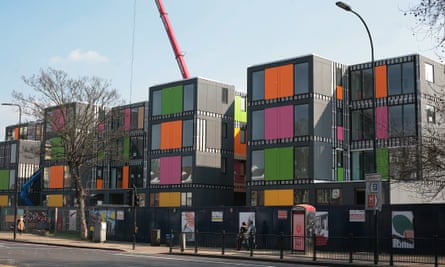Pop-ups are now ubiquitous in our cities. Whether it’s airy white retail spaces selling Kanye West’s Pablo merch, unassuming cornershops doubling as the spot where Frank Ocean chooses to launch his new album or shipping containers being made into temporary accommodation for homeless people – in one form or another they are now part of the fabric of many cities around the world.
Which is why it takes a fairly outlandish one to make you look up from the bowl of Lucky Charms you’re eating in a replica Saved by the Bell diner. But San Francisco residents have recently been invited to a pop-up that does just that: a dinner in a dumpster.
The idea is simple: people gather around a large table and enjoy a six-course meal of largely salvaged ingredients. The organisers work with grocery stores, restaurants, farms, juicieries and others to procure food that would otherwise go to waste, then craft a menu from the take. The dining room? A retrofitted, candlelit dumpster.
“While we were eating dessert, the city sanitation truck came to the building next to us to pick up their trash and recycling,” says Josh Treuhaft, the founder of Salvage Supperclub. “There we were, 16 guests eating dessert in a dumpster on the street, right next to an active Recology truck picking up the waste from the neighbours. It was quite surreal.”
So are Salvage Supperclub, who have also over the last two years hosted dinners both inside and outside dumpsters in New York, California and Japan, serious? Or are they evil geniuses trolling the cities’ gong bath-loving residents?

Treuhaft assures me it’s the former. The underlying philosophy, he says, is genuine: “Something we call Eat Everything, which is about inspiring and empowering anyone who cooks and eats to make the most of the edible food in their lives. Whether that’s past the sell-by date, aesthetically unappealing, food that you don’t usually think of eating (like a broccoli stalk or a cauliflower leaf, or a watermelon rind), stale bread …”
Having worked for a long time on food waste, but struggled to get people jazzed up about it – “Waste is seen as icky and taboo,” he says – he realised the way to do it was to focus instead on food. His “a-ha moment” came when he posted a picture of carrot and ginger pulp, the waste from a juice his girlfriend had just made, on Instagram and asked for culinary ideas. “I got a bunch of great responses … I started realising that the creative, tasty, experiential, social side of food was really where the magic was.”
Dinners, he realised, were one way to do that. And he says they’ve worked. “I’ve gotten unsolicited emails from people saying that they’ve totally changed the way they shop and cook, and that they’ve become far less judgmental about the way their produce looks.”

Surely with this, as with all the other Portlandia-esque city pop-ups that actually have good intentions, if it works, then the joke’s on us? “The fact that you and I are even talking leads me to believe that there actually is a piece of the dumpster dining room that’s doing exactly what it was intended to do: start a conversation.”
A raft of other pop-ups are similarly well-intentioned. A “parasite cinema” in Auckland, New Zealand turned a building’s stairwell into a spot for communal film screenings. It was designed by a group of architects in response to the lack of social interaction at bus stops and launderettes.
A pop-up town square, where a miniature clock tower was attached to the back of a bike in Cricklewood, might sound a bit naff. But it was designed to get people thinking about how best to go about creating useable public space and a sense of community in that corner of north-west London.
In the wake of the 2011 Christchurch earthquake, a pop-up cardboard cathedral kept life – or at least one aspect of it – ticking over for some of the city’s residents. And in London’s borough of Lewisham, “the UK’s first pop-up village” was erected earlier this year for households on the waiting list for council homes.
Of course, some pop-ups in cities have been as silly as they sound: the upcycled Berlin phonebooth that became the world’s tiniest disco; the fully functioning, un-repurposed loo cubicles that became the setting for intimate dinners over loo paper holders in an Amsterdam concert hall; and the bar in London where your beer is served by dogs. Not to mention the planned Death Row dinner pop-up that was shelved before it even opened its doors.
But in the post-crash economy, pop-ups – both the daft and the didactic – will surely continue to be a feature of our urban environments, despite recent talk of economic uncertainty deterring pop-up retailers from taking on longer leases.
With our cities increasingly in flux – as a result of sweeping demographic shifts, environmental factors and continuing economic instability – pop-ups, for all the conflicting ideologies they embody, often help unlock urban spaces that would otherwise stand empty for culture, community ... and consumerism. Now pass the aged zucchini butter on yesterday’s toast.
Follow Guardian Cities on Twitter and Facebook and join the discussion
Comments (…)
Sign in or create your Guardian account to join the discussion